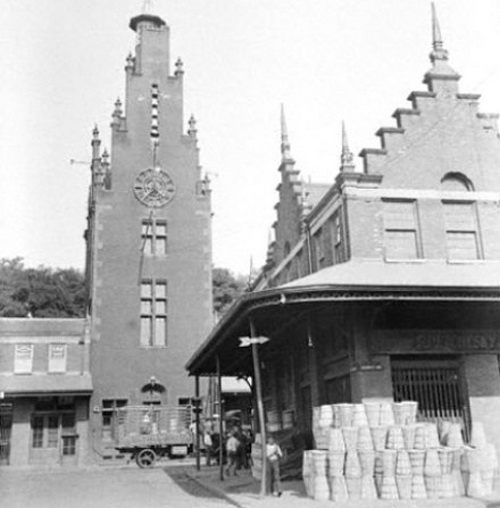
The Wallabout Market, once the second largest market in the world.
Those encountering Rapeleye Street on the Cobble Hill/Red Hook border may not wonder much about it except to ponder how it’s pronounced. The Rapalje (original spelling) family history goes back to the very origins of New York City when it was called Nieuw Netherlands and the area (now part of the Brooklyn Navy Yard) was known by the Lenape Indians as “Rennegachonk.” Catalina Trico and Joris Jansen Rapalje, Walloons, married just four days before their ship left Amsterdam on January 25, 1624 for America and were one of the first to buy land in the wilderness of lower Manhattan. They soon moved their homestead across the river to the new village of Breucklen where they had a long and fruitful marriage. The original grant to this 335 acres was made in 1637 to Rapalje by two Indian chiefs and was renamed Waal Boght, from the Dutch, meaning either “Bend in the River” or “Bay of Walloons” and is now Wallabout Bay. Joris Jansen Rapalje was one of the first white settlers on the Long Island. The Rapaljes gave birth to and baptized eleven children—the first child, Sarah, was the first European female born in what would become New York, though whether she was born in Brooklyn or upstate New York is in dispute. It is believed that the Rapaljes have over a million descendants.
A map of the town of Brooklyn dated 1766 & 1767 notes the location of the Rapalje house, which by that time was owned by the Schencks. In 1781 John Johnson and his brothers purchased a parcel of the Rapalje land, and built the area’s original shipyard. The Martin Schenk family conveyed the remainder of the property for a consideration to the commissioners of naval hospitals for the erection of same about 1811. Nearly 75 years later, the United States government leased a part of this property to the City of Brooklyn, namely the northwest corner of Washington and Flushing Avenues, extending through to the Kent Avenue Basin. In June of 1894, the City of Brooklyn took title to a second piece of land to be used for the purposes of the Wallabout Market (see photo).
The Wallabout Market was once the second largest market in the world. It featured two-story brick structures designed in a Dutch/Flemish style, reflecting the history of the area. The market was an unfortunate victim of World War II when the Navy Yard expanded to seven times its previous size, gobbling up the land the Market sat on for the war effort. In 1966, the Navy closed the Yard. At that time, it employed more than 9,000 workers. In 1967, 260 acres of the yard were sold to the City of New York for $24,000,000 and was reopened in 1971 as a city-owned industrial park. Today the land where the Rapalje’s farm stood is a thriving industrial park with over 40 buildings, 230 tenants and 5,000 employees under the direction of the Brooklyn Navy Yard Development Corporation.
(Ruth Edebohls is the Coordinator of Urban Tours at the Center for the Urban Environment. To learn more about the Center visit us at www.thecue.org.)
NAVY YARD TOURS: The Center for the Urban Environment will be hosting three bus tours of the Brooklyn Navy Yard this spring—March 1st, April 5th, and May 3rd. For more information, call 718-788-8500, ext. 217 or check our website, www.thecue.org

3 responses so far ↓
1 Brenda from Flatbush // Jan 9, 2009 at 5:04 pm
A connection between “Wallabout” and Walloons…who woulda thunk it? I figured there was a “wall about” some area. Amazing tale.
2 Susan Rapalee // Jan 11, 2009 at 10:00 am
Thank you for your article. I am a direct descendant of Catalina & Joris, from the branch of the family that moved to western New York State a few hundred years back. I didn’t know much about the family when I moved to Brooklyn almost 30 years ago, but as I learned more I imagined myself having been inevitably drawn here by the bones in the ground, as it were.
3 Working Harbor Committee 6/15/09 tour part 1 « The Newtown Pentacle // Jun 25, 2009 at 12:44 am
[…] from gowanuslounge.com. click here for the full post […]